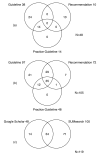Developing search strategies for clinical practice guidelines in SUMSearch and Google Scholar and assessing their retrieval performance
- PMID: 17603909
- PMCID: PMC1925105
- DOI: 10.1186/1471-2288-7-28
Developing search strategies for clinical practice guidelines in SUMSearch and Google Scholar and assessing their retrieval performance
Abstract
Background: Information overload, increasing time constraints, and inappropriate search strategies complicate the detection of clinical practice guidelines (CPGs). The aim of this study was to provide clinicians with recommendations for search strategies to efficiently identify relevant CPGs in SUMSearch and Google Scholar.
Methods: We compared the retrieval efficiency (retrieval performance) of search strategies to identify CPGs in SUMSearch and Google Scholar. For this purpose, a two-term GLAD (GuideLine And Disease) strategy was developed, combining a defined CPG term with a specific disease term (MeSH term). We used three different CPG terms and nine MeSH terms for nine selected diseases to identify the most efficient GLAD strategy for each search engine. The retrievals for the nine diseases were pooled. To compare GLAD strategies, we used a manual review of all retrievals as a reference standard. The CPGs detected had to fulfil predefined criteria, e.g., the inclusion of therapeutic recommendations. Retrieval performance was evaluated by calculating so-called diagnostic parameters (sensitivity, specificity, and "Number Needed to Read" [NNR]) for search strategies.
Results: The search yielded a total of 2830 retrievals; 987 (34.9%) in Google Scholar and 1843 (65.1%) in SUMSearch. Altogether, we found 119 unique and relevant guidelines for nine diseases (reference standard). Overall, the GLAD strategies showed a better retrieval performance in SUMSearch than in Google Scholar. The performance pattern between search engines was similar: search strategies including the term "guideline" yielded the highest sensitivity (SUMSearch: 81.5%; Google Scholar: 31.9%), and search strategies including the term "practice guideline" yielded the highest specificity (SUMSearch: 89.5%; Google Scholar: 95.7%), and the lowest NNR (SUMSearch: 7.0; Google Scholar: 9.3).
Conclusion: SUMSearch is a useful tool to swiftly gain an overview of available CPGs. Its retrieval performance is superior to that of Google Scholar, where a search is more time consuming, as substantially more retrievals have to be reviewed to detect one relevant CPG. In both search engines, the CPG term "guideline" should be used to obtain a comprehensive overview of CPGs, and the term "practice guideline" should be used if a less time consuming approach for the detection of CPGs is desired.
Figures
Similar articles
-
Google Scholar versus PubMed in locating primary literature to answer drug-related questions.Ann Pharmacother. 2009 Mar;43(3):478-84. doi: 10.1345/aph.1L223. Epub 2009 Mar 3. Ann Pharmacother. 2009. PMID: 19261965
-
Optimal search strategies for detecting cost and economic studies in EMBASE.BMC Health Serv Res. 2006 Jun 6;6:67. doi: 10.1186/1472-6963-6-67. BMC Health Serv Res. 2006. PMID: 16756662 Free PMC article.
-
An overview of the design and methods for retrieving high-quality studies for clinical care.BMC Med Inform Decis Mak. 2005 Jun 21;5:20. doi: 10.1186/1472-6947-5-20. BMC Med Inform Decis Mak. 2005. PMID: 15969765 Free PMC article.
-
Literature search using PubMed: an essential tool for practicing evidence- based medicine.J Assoc Physicians India. 2006 Apr;54:303-8. J Assoc Physicians India. 2006. PMID: 16944614 Review.
-
Are clinical practical guidelines (CPGs) useful for health services and health workforce planning? A critique of diabetes CPGs.Diabet Med. 2010 May;27(5):570-7. doi: 10.1111/j.1464-5491.2010.02981.x. Diabet Med. 2010. PMID: 20536954 Review.
Cited by
-
How equity is addressed in clinical practice guidelines: a content analysis.BMJ Open. 2014 Dec 5;4(12):e005660. doi: 10.1136/bmjopen-2014-005660. BMJ Open. 2014. PMID: 25479795 Free PMC article.
-
MEDLINE search retrieval issues: A longitudinal query analysis of five vendor platforms.PLoS One. 2021 May 6;16(5):e0234221. doi: 10.1371/journal.pone.0234221. eCollection 2021. PLoS One. 2021. PMID: 33956834 Free PMC article.
-
Search results outliers among MEDLINE platforms.J Med Libr Assoc. 2019 Jul;107(3):364-373. doi: 10.5195/jmla.2019.622. Epub 2019 Jul 1. J Med Libr Assoc. 2019. PMID: 31258442 Free PMC article.
-
Follow-up care for men with prostate cancer and the role of primary care: a systematic review of international guidelines.Br J Cancer. 2009 Jun 16;100(12):1852-60. doi: 10.1038/sj.bjc.6605080. Epub 2009 May 12. Br J Cancer. 2009. PMID: 19436297 Free PMC article.
-
Clinical Practice Guidelines (CPGs) for stroke rehabilitation from Low- and Middle-Income Countries (LMICs): Protocol for systematic review.PLoS One. 2023 Nov 9;18(11):e0293733. doi: 10.1371/journal.pone.0293733. eCollection 2023. PLoS One. 2023. PMID: 37943755 Free PMC article.
References
-
- Straus SE, Richardson WS, Glasziou P, Haynes RB. Evidence-Based Medicine: How to Practice and Teach EBM. 3rd. Edinburgh , Elsevier; 2005. Introduction; pp. 1–12.
-
- Committee to Advise the Public Health on Clinical Guidelines. Institute of Medicine . Definitions of Key Terms. In: Field MJ, Lohr KN, editor. Clinical Practice Guidelines: Directions for a New Program. Washington, D.C. , National Academy Press; 1990. pp. 33–51.
MeSH terms
LinkOut - more resources
Full Text Sources



